Nursing Ati Med-surg exam verified and scored A
Document Content and Description Below
Nursing Ati Med-surg exam Question 1 The nurse is assessing a 31-year-old female with abdominal pain. The nurse notes deep tenderness over the right side of the abdomen that is one-third of the distan... ce from the right iliac crest to the umbilicus and documents this finding as Answers: a. Cullen's sign b. Rovsing sign c. McBurney's sign d. Grey-Turner's sign Question 2 A client with Crohn's disease (regional enteritis) who is taking sulfasalazine (Azulfidine) asks the nurse why this medication is necessary. Which information should the nurse include in the response? Answers: a. The drug decreases abdominal cramping by slowing peristalsis b. The drug decreases prostaglandin production in the bowel so it decreases inflammation c. The drug inhibits neurotransmission of pain impulses d. The drug stimulates the release of endorphins so pain is relieved Question 3 Which assessment finding would the nurse need to report most quickly to the health care provider regarding a patient with acute pancreatitis? Answers: a. Nausea and vomiting b. Hypotonic bowel sounds c. Abdominal tenderness and guarding d Muscle twitching and finger numbness Question 4 A nurse in a burn treatment center is caring for a client who is admitted with severe burns to both lower extremities and is scheduled for an escharotomy. The client's spouse asks the nurse what the procedure entails. Which of the following nursing statements is appropriate? Answers: a. "A solution will be applied to the burned areas to accelerate the sloughing off of dead tissue." b. "A piece of healthy skin will be removed from an unburned area and grafted over the burned area." c. "Dead tissue will be non-surgically removed." d. "Large incisions will be made in the eschar to improve circulation." Question 5 A nurse in am emergency department is caring for a client who has deep partial- and full-thickneww burns to his chest, abdomen, and upper arms. What is the nurse's priority intervention for this client during the resuscitation of phase of injury? Answers: a. Initiate fluid resuscitation b. Medicate for pain c. Insert an indwelling urinary catheter d. Maintain the airway Question 6 A nurse in an emergency department is caring for a client who has burns on the front and back of both his legs and arms. Using the rule of nines the nurse should document burns to which percentage of the client’s total body surface area (TBSA)? Answers: a. 9 b. 18 c. 36 d. 54 Question 7 A nurse in an emergency department is reviewing the medical record of a client who has an extensive burn injury. The nurse should expect which of the following laboratory findings in this client? Answers: a. Metabolic alkalosis b. Hypervolemia c. Hyperkalemia d. Low hemoglobin Question 8 A nurse in the emergency department is caring for a client who has a 30% burn injury to her lower extremities. Which of the following interventions should the nurse perform first? Answers: a. Clean and dress the wound. b. Administer pain medication. c. Administer a tetanus booster. d. Administer IV fluids. Question 9 A nurse is assessing a client who is brought to the emergency room with burn injuries. Which of the following findings should the nurse identify as a deep partial-thickness burn? Answers: a. The burned area is black in color and pain is absent. b. The burned area is pink in color with blisters present. c. The burned area is red in color with eschar present. d. The burned area is yellow in color with severe edema. Question 10 A nurse is assessing the depth and extent of injury on a client who has severe burns to the face, neck, and upper extremities. Which of the following factors is the nurse’s priority when assessing the severity of the client’s burns? Answers: a. Age of the client b. Associated medical history c. Location of the burn d. Cause of the burn Question 11 A nurse is preparing to start an IV infusion of lactated Ringer's for a client who sustained a burn injury. The client is prescribed 5,200 mL of fluid onver the first 24hr. How many nL/hr should the nurse set the pump to infuse for the first 8 hr? (Round the answer to the nearest whole number. Use a leading zero if it applies. Do not use a trailing zero.) Answers: a 450 mL/hr b. 325 mL/hr c. 1200 mL/hr d. 650 mL/hr Question 12 Extraintestinal symptoms that are seen in both ulcerative colitis and Crohn's disease are Answers: a. osteoorosis and conjunctivitis b. peptic ulcer disease and uveitis c. erythema nodosum and arthritis d. gluten intolerance and gallstones Question 13 Which sign/symptom should the nurse expect to find in a client diagnosed with ulcerative colitis? Answers: a. Twenty bloody stools a day b. Oral temperature of 102 c. Hard, rigid abdomen d Urinary stress incontinence Question 14 The nurse is planning care for a 68-year-old patient with an abdominal mass and suspected bowel obstruction. Which factor in the patient's history increases the patient's risk for colorectal cancer? Answers: a. Osteoarthritis b. History of colorectal polyps c History of lactose intolerance d Use of herbs as dietary supplements Question 15 The nurse is admitting a 67-year-old patient with new-onset steatorrhea. Which question is most important for the nurse to ask? Answers: a "How much milk do you usually drink?" b. "Have you noticed a recent weight loss?" c. "What time of day do your bowels move?" d. "Do you eat meat or other animal products?" Question 16 During an acute attack of diverticulitis, the paitent is Answers: a. monitored for signs of peritonitis b treated with daily medicated enemas c. prepared for surgery to resect the involved colon d. provided with a heating pad to apply to the left lower quadrant Question 17 The nurse is teaching a class on diverticulosis. Which interventions should the nurse discuss when teaching ways to prevent an acute exacerbation of diverticulosis? (select all that apply) Answers: a. Eat a high fiber diet b. Increase fluid intake c. Elevate the HOB after eating d. Walk 30 minutes a day Question 18 The nurse will ask a 64-year-old patient being admitted with acute pancreatitis specifically about a history of Answers: a. diabetes mellitus. b. high-protein diet. c. cigarette smoking d alcohol consumption Question 19 An elderly client presents with fever, leukocytosis, left lower quadrant pain, and diarrhea alternating with constipation. The nurse conludes that these are frequently seen in clients with which health problem? Answers: a. Appendicitis b. Diverticulitis c. Pancreatitis d. Peritonitis Question 20 A patient is admitted to the Emergency Department with 50% burns to the chest and arms. The skin is white, dry, and there is no pain. The nurse assesses the type of burn the patient has as which of the following? Answers: a. Superficial thickness b Superficial partial thickness c. Deep partial thickness d. Full thickness Question 21 A nurse is developing a plan of care for a client who is rehabilitating from major burns. Which of the following interventions should the nurse include to provide emotional support? Answers: a. Assign assistive personnel to keep his room neat and clean. b. Rotate nursing staff so he can have varied interactions. c. Talk with the client during wound care. d. Keep family members aware of his condition. Question 22 A nurse is developing a teaching plan for a client who has an ileostomy and will require stoma care. Which of the following information should the nurse include? Answers: a. Empty the pouch when it is 1/2 full. b. Hold pressure on the skin barrier for 10 to 15 sec to secure the seal. c. Clean the peristomal skin four times a day. d. Expect firm fecal content. Question 23 A nurse is teaching a client who is receiving radiation therapy about skin care. Which of the following instructions should the nurse include? Answers: a. Walk outside in the early mornings. b. Wash the irradiated area following treatment sessions to remove the markings c Vigorously rub the skin dry after bathing. d Keep the temperature in the home at least 33° C (91.4° F). Question 24 A nurse working in an emergency room is caring for a client who has third degree frostbite to both lower extremities. The nurse should plan to take which of the following actions? Answers: a Immerse the legs in cool water. b. Elevate the legs. c. Massage the legs d. Apply dry heat to the legs. Question 25 A nurse is providing instructions about bowel cleansing with polyethylene glycol-electrolyte solution (PEG) for a client who is going to have a colonoscopy. Which of the following information should the nurse include? Answers: a. "To prevent dehydration, drink an additional liter of fluid during preparation time." b. "Expect bowel movements to begin 3 hr following completion of solution." c. "Abdominal bloating might occur." d. "Drink 400 mL every hour until bowel movements are clear." Question 26 A nurse is providing instructions for a 52-year-old client who is scheduled for a colonoscopy. The client reports that he has not had the procedure before and is very anxious about feeling pain during the procedure. Which of the following responses by the nurse is appropriate? Answers: a. "Don't worry; most clients dislike the prep more than the procedure itself." b. "I know you’re anxious, but this procedure is recommended for people your age." c. "Before the examination, your provider will give you a sedative that will make you sleepy." d. "After you have signed the consent form, we can talk more about this." Question 27 A nurse is caring for a client who has diverticular disease. When palpating the client’s abdomen, in which of the following locations should the nurse expect the client to report abdominal pain? Answers: a Lower left quadrant b. Upper left quadrant c. Lower right quadrant d. Upper right quadrant Question 28 A nurse is caring for a client following an esophagogastroduodenoscopy (EGD) procedure. Which of the following assessments is the nurse's priority? Answers: a Pain b. Nausea c. Gag reflex d. Level of consciousness Question 29 A nurse is caring for a client who has ulcerative colitis and is teaching the client about the common link with Crohn's disease. Which of the following information should the nurse include? Answers: a. Both are inflammatory b. Both begin in the rectum c. Both manifest fistula formation d. Both require frequent surgery Question 30 A nurse is assessing a client who is 3 days postoperative following abdominal surgery and notes the absence of bowel sounds, abdominal distention, and the client passing no flatus. Which of the following conditions should the nurse suspect? Answers: a. Ulcerative colitis b. Cholecystitis c. Paralytic ileus d. Wound dehiscence Question 31 A nurse is teaching a client who has a history of ulcerative colitis and a new diagnosis of anemia. Which of the following manifestations of colitis should the nurse identify as a contributing factor to the development of the anemia? Answers: a. Dietary iron restrictions b. Intestinal malabsorption syndrome c. Chronic blood loss d. Intestinal parasites Question 32 A nurse is interviewing a client who has acute pancreatitis. Which of the following factors should the nurse anticipate finding in the client's history? Answers: a. Gallstones b. Hypolipidemia c COPD d. Diabetes mellitus Question 33 A nurse in a PACU is assessing a client who has a newly created colostomy. Which of the following findings should the nurse report to the provider? Answers: a. Stoma oozing red drainage b. Shiny, moist stoma c Purplish-colored stoma d. Rosebud-like stoma orifice Question 34 A nurse is assisting a group of clients in an outpatient clinic. For which of the following clients should the nurse anticipate scheduling a colonoscopy? Answers: a. 56-year-old who had a colonoscopy 6 years ago b. 34-year-old who reports a new onset of constipation c. 32-year-old who has a sister who died of colon cancer d. 51-year-old who is being seen for an annual physical examination Question 35 A nurse is planning care for a client who has diverticulitis. Which of the following menu selections should the nurse include in the plan? Answers: a Turkey sandwich with celery sticks b. Sliced ham with green salad c. Pork tenderloin with green peas d. Grilled chicken breast with white rice Question 36 A nurse is providing preoperative teaching to a client who is to undergo an open bowel resection at 1300 next week. Which of the following statements by the client indicates the need for further teaching? Answers: a. "I will be able to eat solid food when I wake up from anesthesia." b. "I will have a glass of juice the morning of my surgery." c. "I understand what risks I can expect with this surgery." d. "I will take time to relax if I get nervous the night before surgery." Question 37 A nurse is caring for a client who has an active upper gastrointestinal bleed. After inserting a NG tube into the client, which of the following findings should the nurse anticipate? Answers: a. Frothy pink drainage b. Dark amber drainage c. Coffee-ground drainage d. Greenish-yellow drainage Question 38 A nurse is providing teaching to a client who has a new colostomy. Which of the following information should the nurse include in the teaching? Answers: a. "You can expect fecal output within 24 hours." b. "You will need to increase your dietary intake of raw vegetables." c. "You can expect the stoma to be purplish in color for the first week." d. "You may experience a small amount of bleeding around the stoma." Question 39 When assessing the patient’s bowel sounds, the nurse: Answers: a. listens to the abdomen after palpation is done. b. places the patient in a relaxed prone position. c. listens to bowel sounds before palpation. d. places a pillow over the patient’s knees. Question 40 The patient is being admitted with GI bleeding. Blood work includes serial hemoglobin and hematocrit levels. The nurse understands that: Answers: a. the hematocrit is a direct reflection of quick blood loss. b. as extravascular fluid enters the vascular space the hematocrit increases. c. the hematocrit value does not change substantially during the first few hours. d. bleeding does not effect the hematocrit level. Question 41 The nurse is caring for a patient with severe pancreatitis and who is orally intubated and on mechanical ventilation. The patient’s calcium level this morning was 5.5 mg/dL. The nurse notifies the provider and: Answers: a. places the patient on seizure precautions. b. expects that the provider will come and remove the endotracheal tube. c. withhold any further calcium treatments. d. place an oral airway at the bedside. Question 42 When caring for the patient with upper GI bleeding, the nurse assesses for which of the following? (Select all that apply.) Answers: a. Severity of blood loss b. Hemodynamic stability c. Vital signs every 30 minutes d. Signs of hypervolemic shock e. Necessity for fluid resuscitation Question 43 Nursing priorities for the management of acute pancreatitis include: (Select all that apply.) Answers: a. managing respiratory dysfunction. b. assessing and maintaining electrolyte balance. c. withholding analgesics that could mask abdominal discomfort. d. stimulating gastric content motility into the duodenum. e. utilizing supportive therapies aimed at decreasing gastrin release. Question 44 The optimal measurement of intravascular fluid status during the immediate fluid resuscitation phase of burn treatment is: Answers: a. blood urea nitrogen. b. daily weight. c. hourly intake and urine output. d. serum potassium. Question 45 The nurse is caring for a burn-injured patient who weighs 154 pounds, and the burn injury covers 50% of his body surface area. The nurse calculates the fluid needs for the first 24 hours after a burn injury using a standard fluid resuscitation formula of 4 mL/kg/% burn of intravenous (IV) fluid for the first 24 hours. The nurse plans to administer what amount of fluid in the first 24 hours? Answers: a. 2800 mL b. 7000 mL c. 14 L d. 28 L Question 46 The patient asks the nurse if the placement of the autograft over his full-thickness burn will be the only surgical intervention needed to close his wound. The nurse’s best response would be: Answers: a. “Unfortunately, an autograft skin is a temporary graft and a second surgery will be needed to close the wound.” b. “An autograft is a biological dressing that will eventually be replaced by your body generating new tissue.” c. "Yes, an autograft will transfer your own skin from one area of your body to cover the burn wound.” d. “Unfortunately, autografts frequently do not adhere well to burn wounds and a xenograft will be necessary to close the wound.” Question 47 When paramedics notice singed hairs in the nose of a burn patient, it is recommended that the patient be intubated. What is the reasoning for the immediate intubation? Answers: a. Carbon monoxide poisoning always occurs when soot is visible. b. Inhalation injury above the glottis may cause significant edema that obstructs the airway. c. The patient will have a copious amount of mucus that will need to be suctioned. d. The singed hairs and soot in the nostrils will cause dysfunction of cilia in the airways. Question 48 Silver is used as an ingredient in many burn dressings because it: Answers: a. stimulates tissue granulation. b. is effective against a wide spectrum of wound pathogens. c. provides topical pain relief. d. stimulates wound healing. Question 49 The nurse is caring for a patient with an electrical injury. The nurse understands that patients with electrical injury are at a high risk for acute kidney injury secondary to: Answers: a. hypervolemia from burn resuscitation. b. increased incidence of ureteral stones. c. nephrotoxic antibiotics for prevention of infection. d. release of myoglobin from injured tissues. Question 50 The nurse is caring for a patient with a chemical burn injury. The priority nursing intervention is to: Answers: a. remove the patient’s clothes and flush the area with water. b. apply saline compresses. c. contact a poison control center for directions on neutralizing agents d. remove all jewelry. [Show More]
Last updated: 1 year ago
Preview 1 out of 11 pages

Buy this document to get the full access instantly
Instant Download Access after purchase
Add to cartInstant download
We Accept:

Reviews( 0 )
$12.00
Document information
Connected school, study & course
About the document
Uploaded On
Jun 19, 2020
Number of pages
11
Written in
Additional information
This document has been written for:
Uploaded
Jun 19, 2020
Downloads
0
Views
72

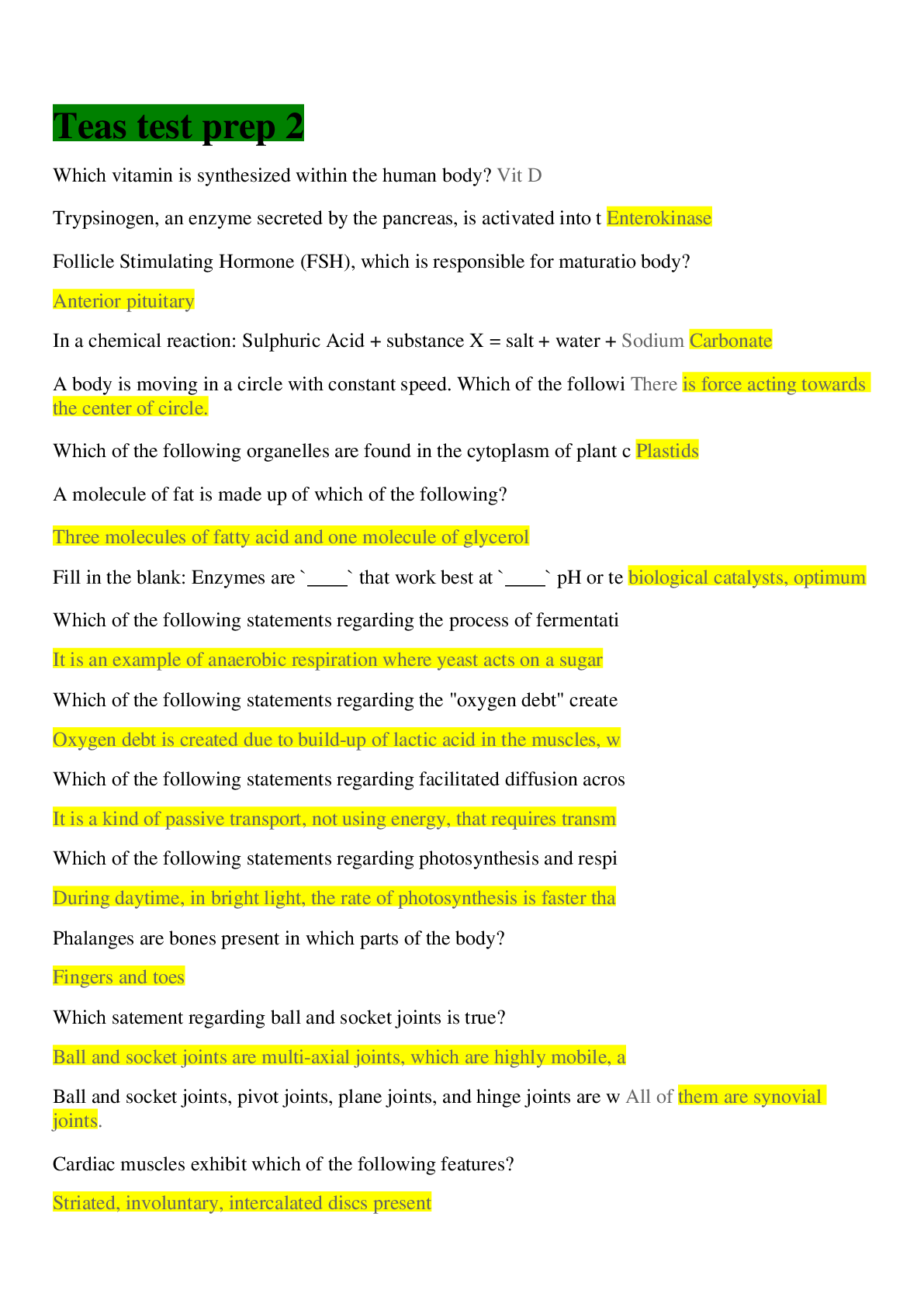
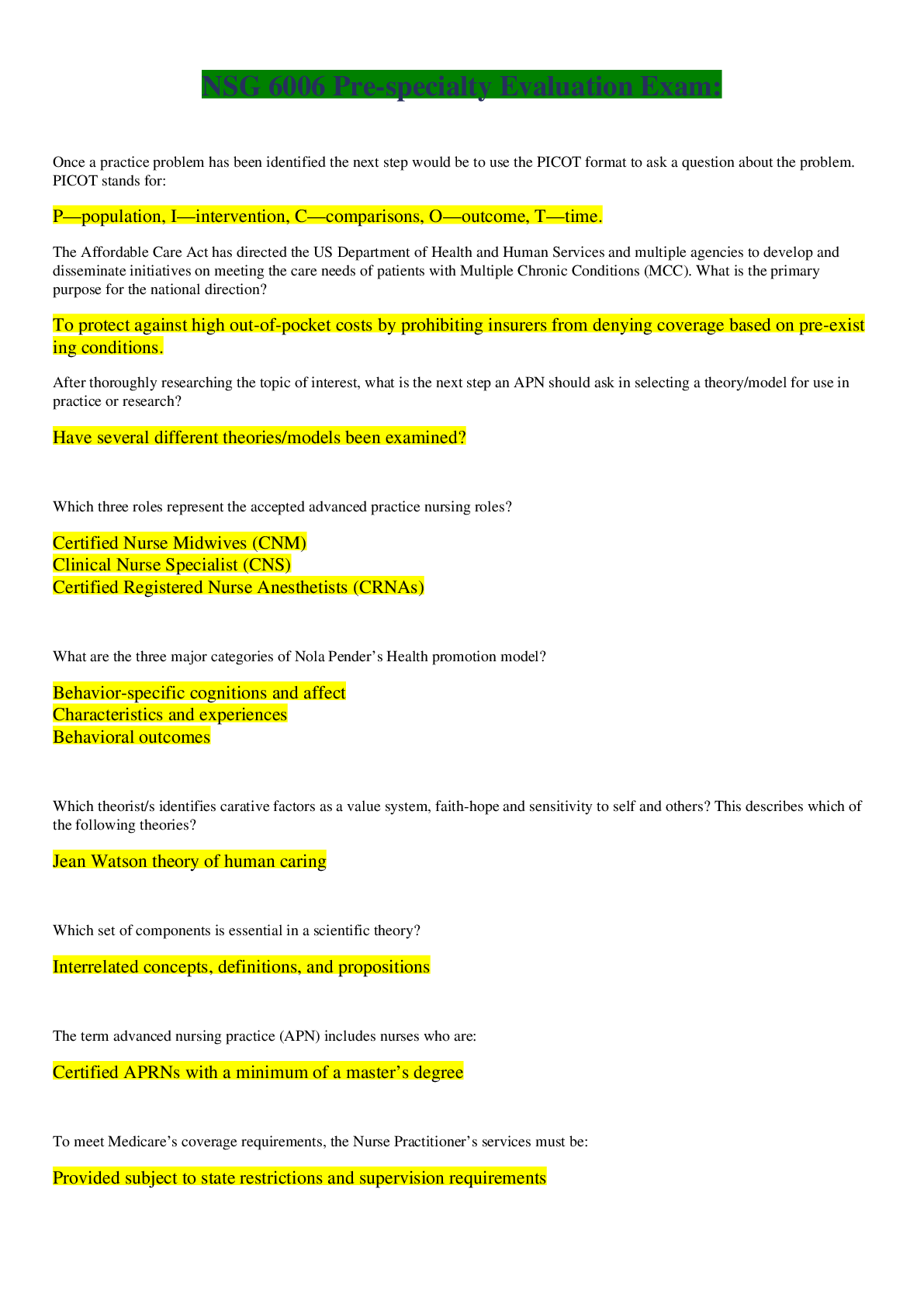
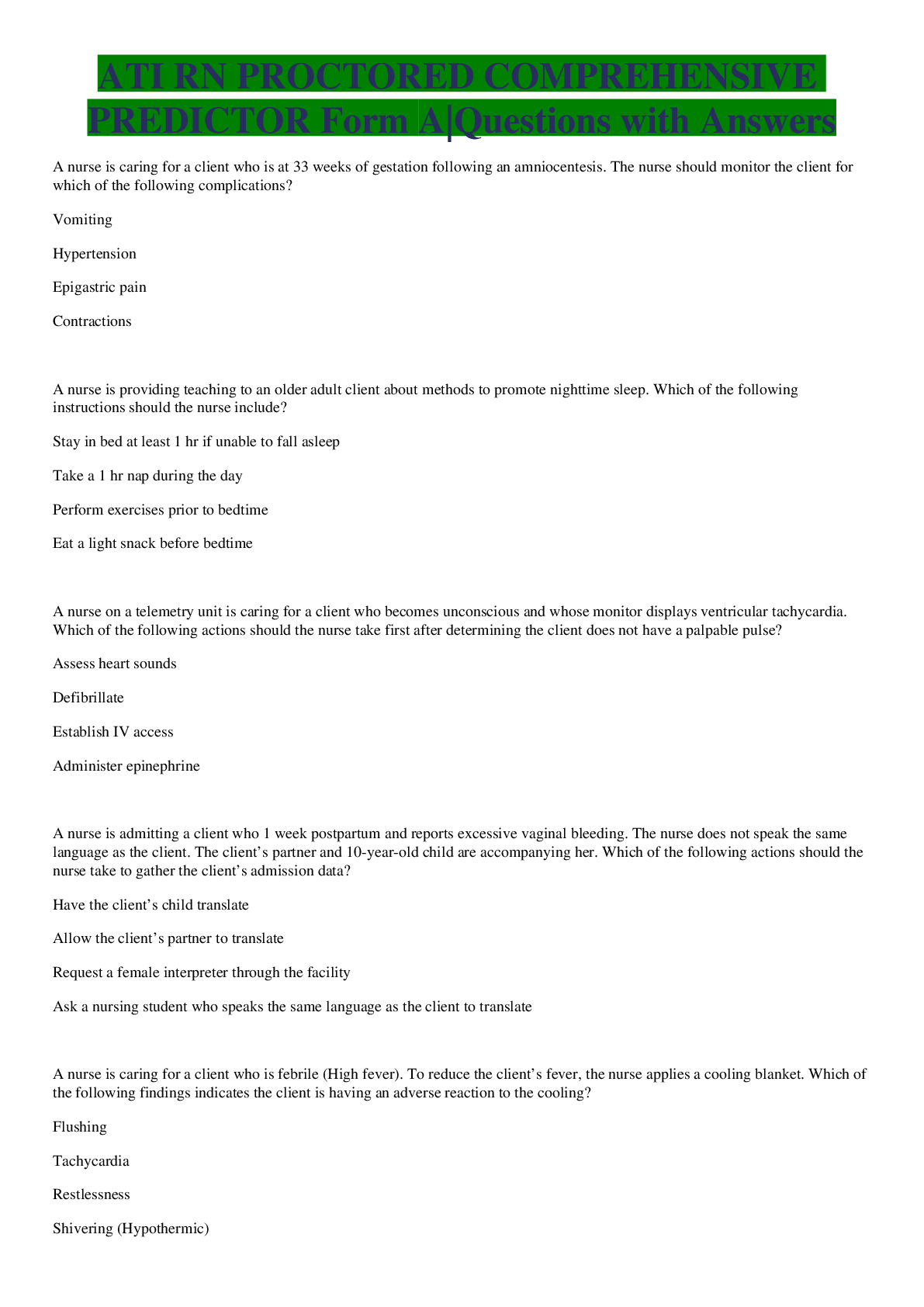
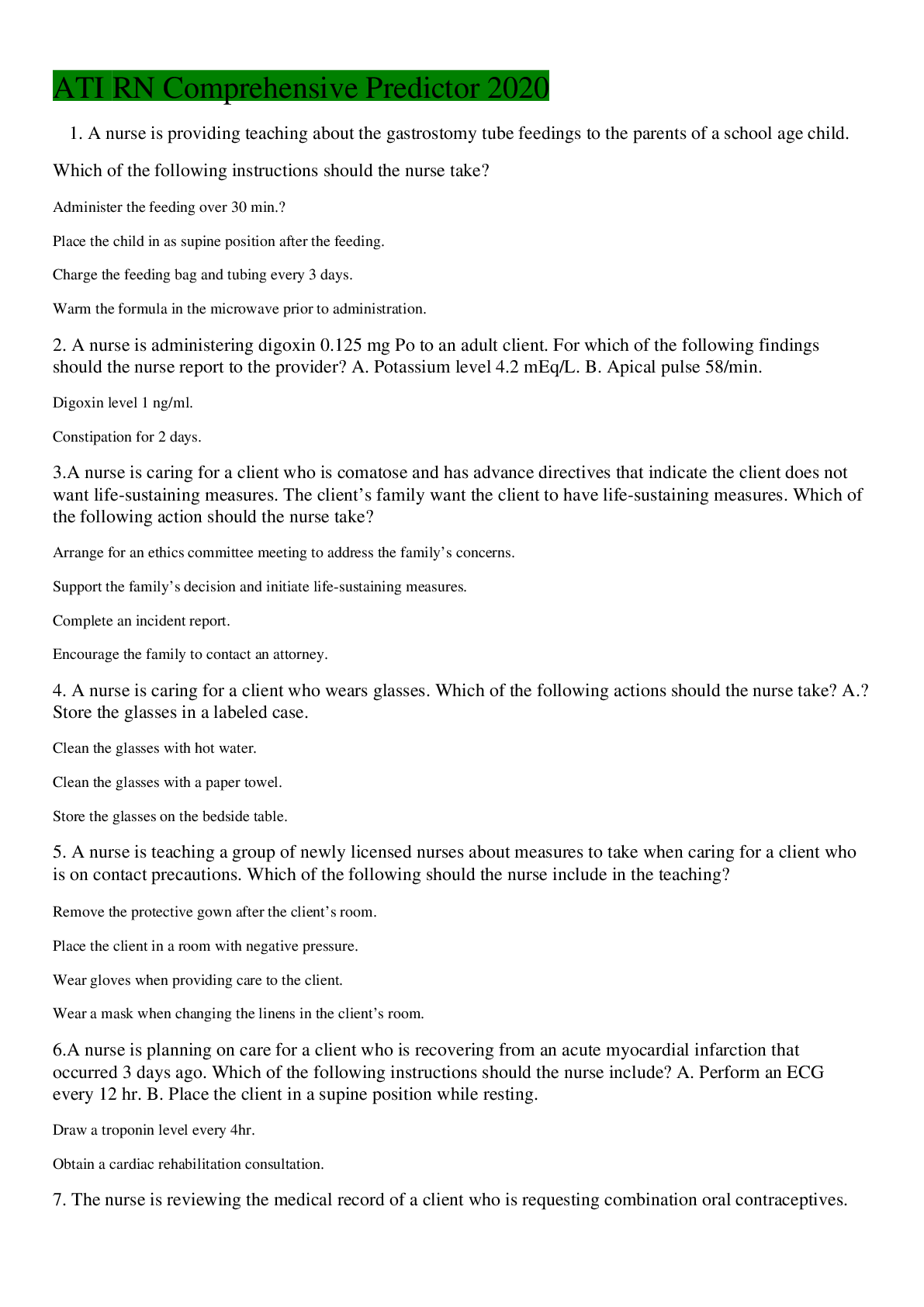


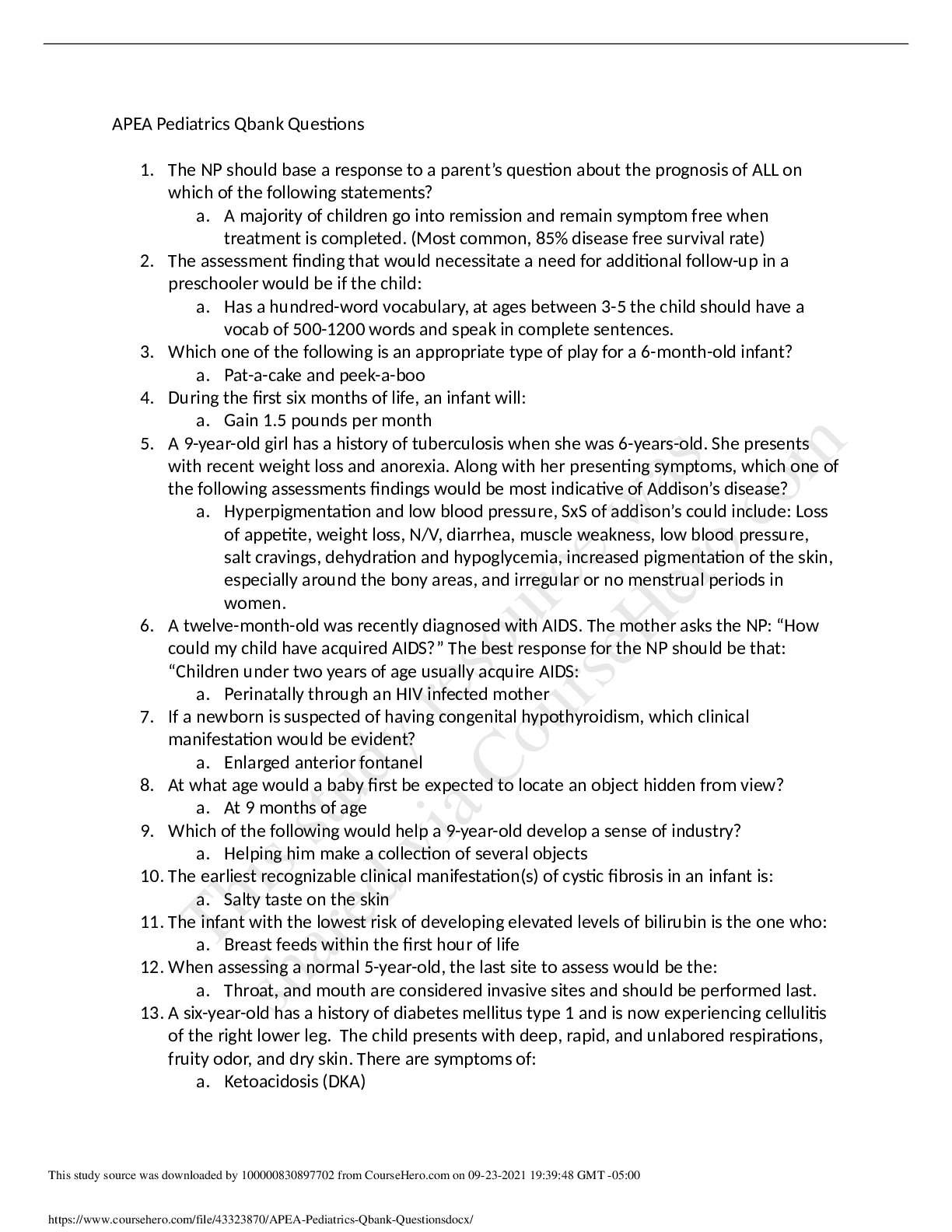
.png)
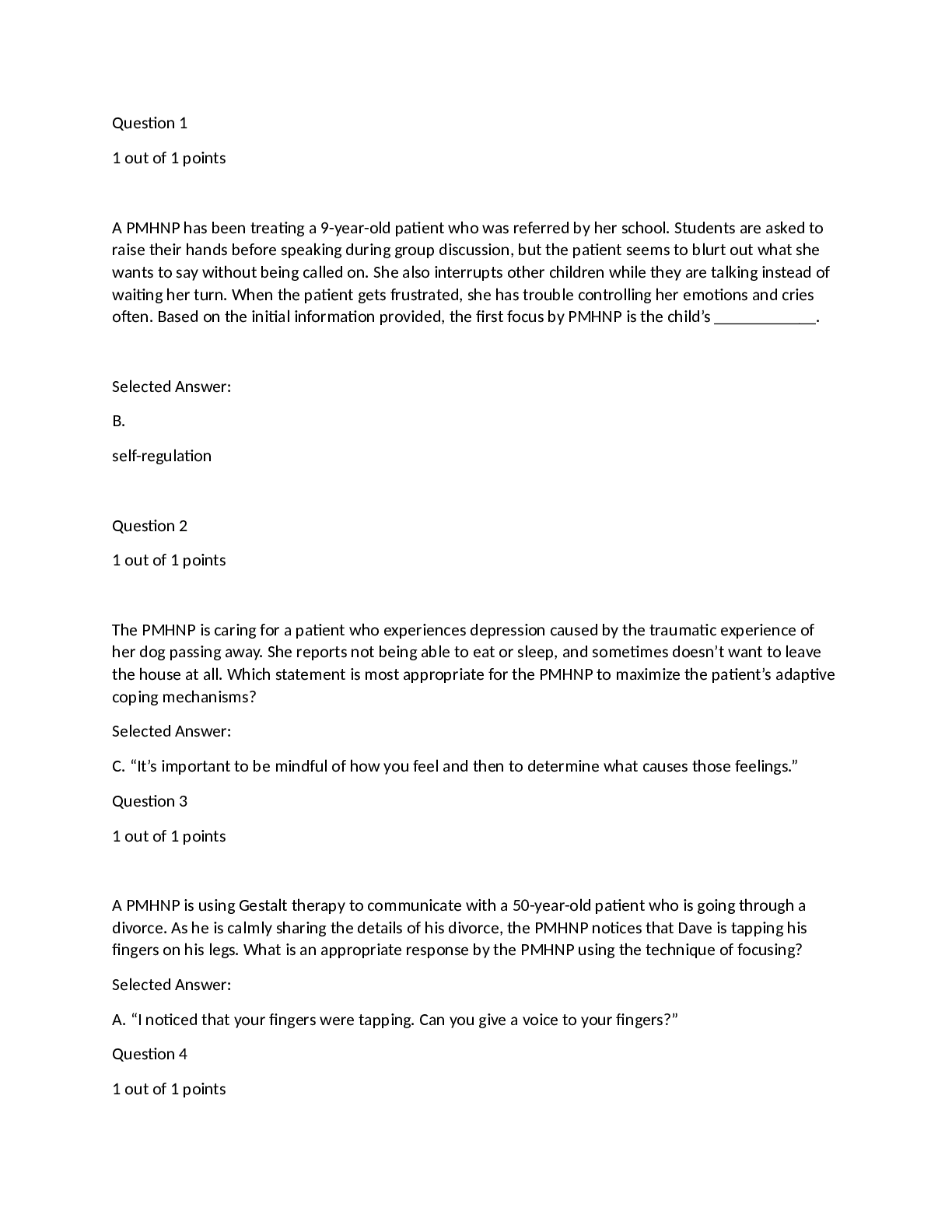

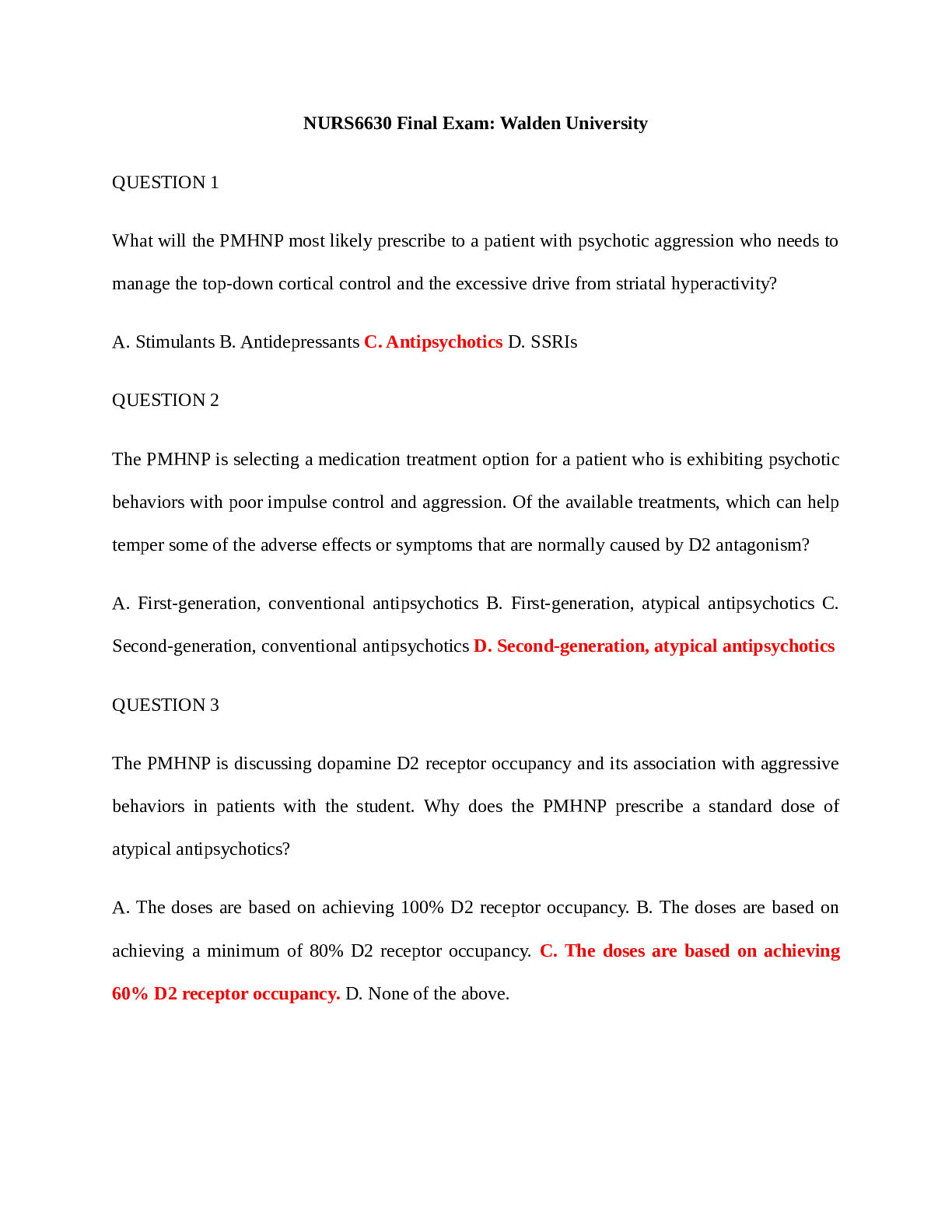
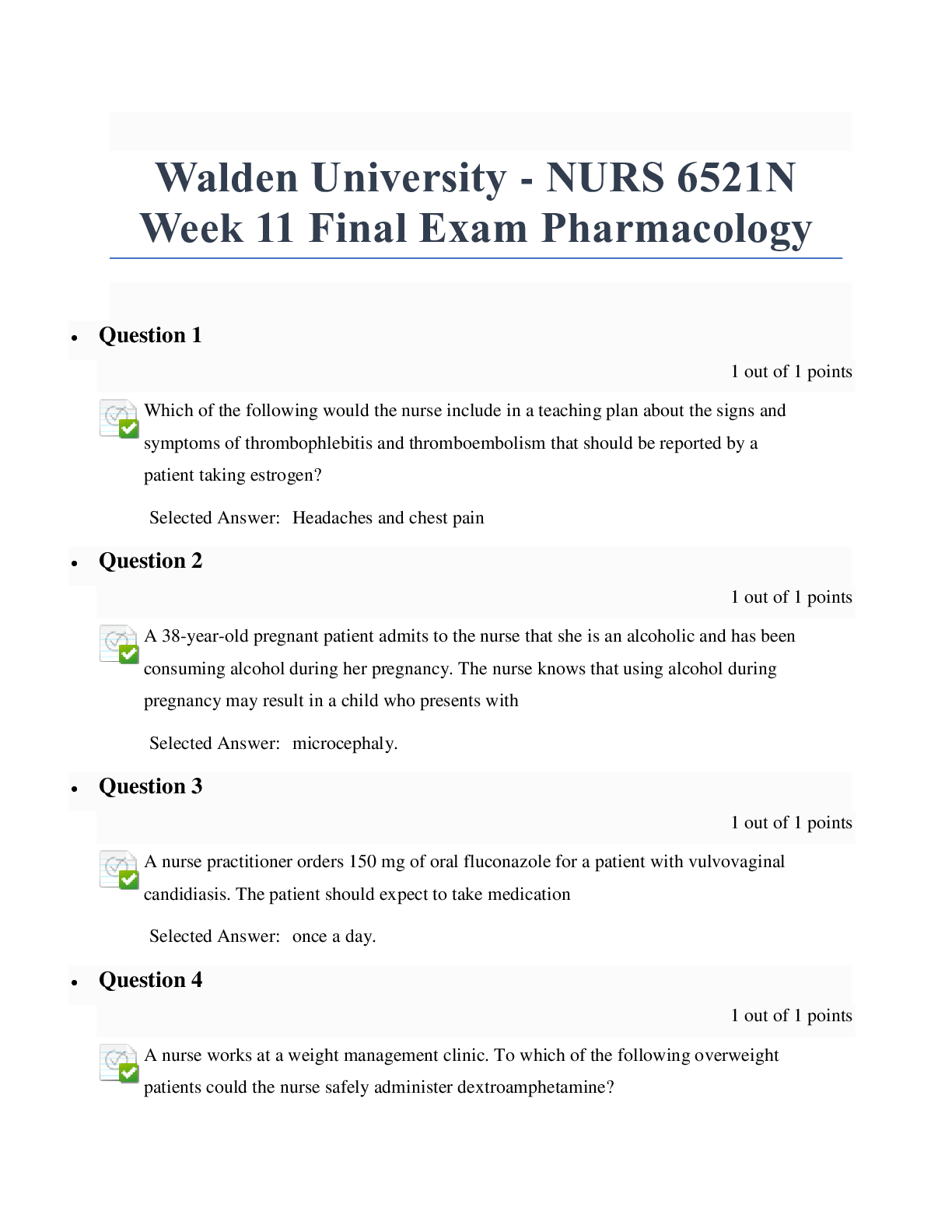
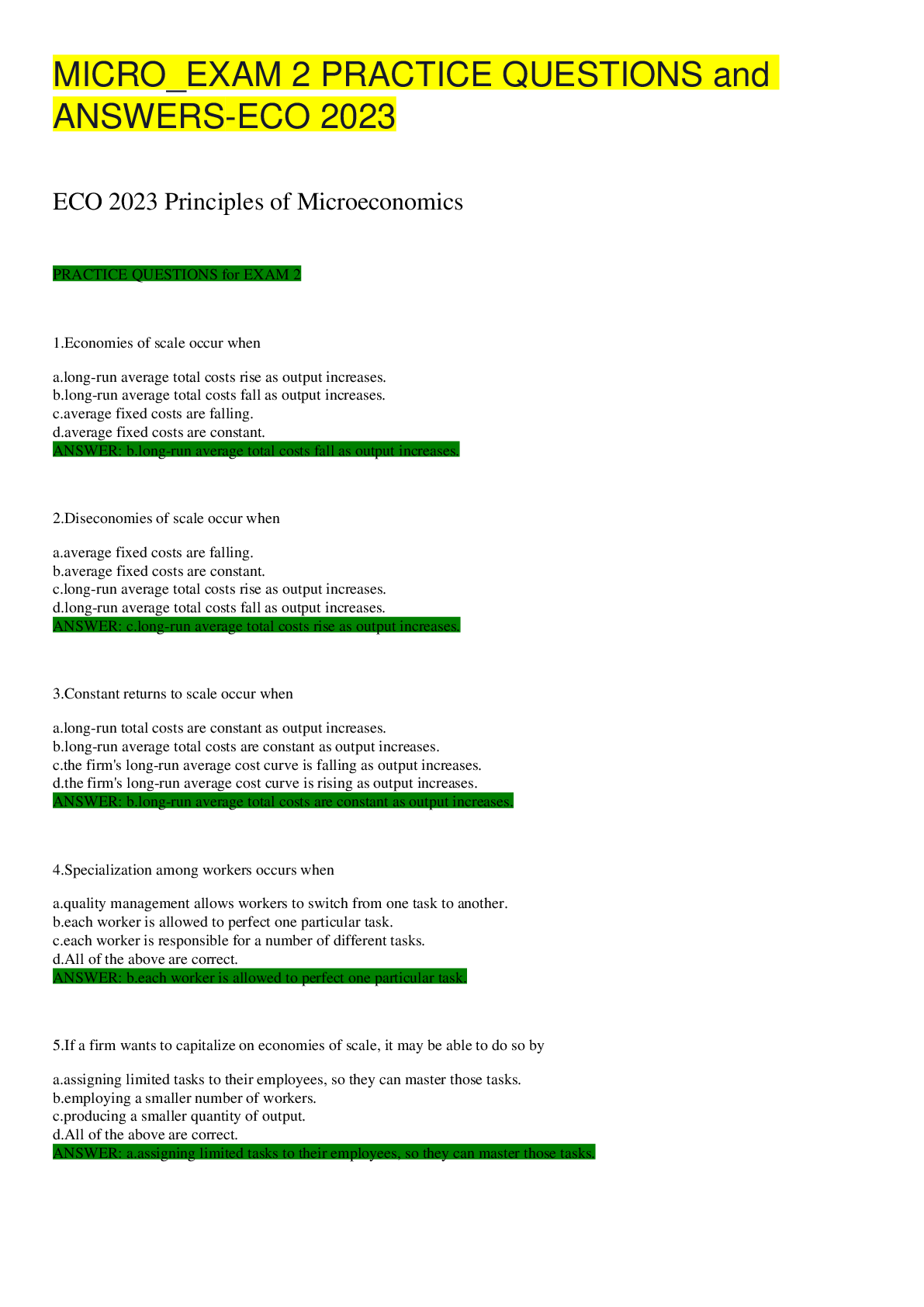


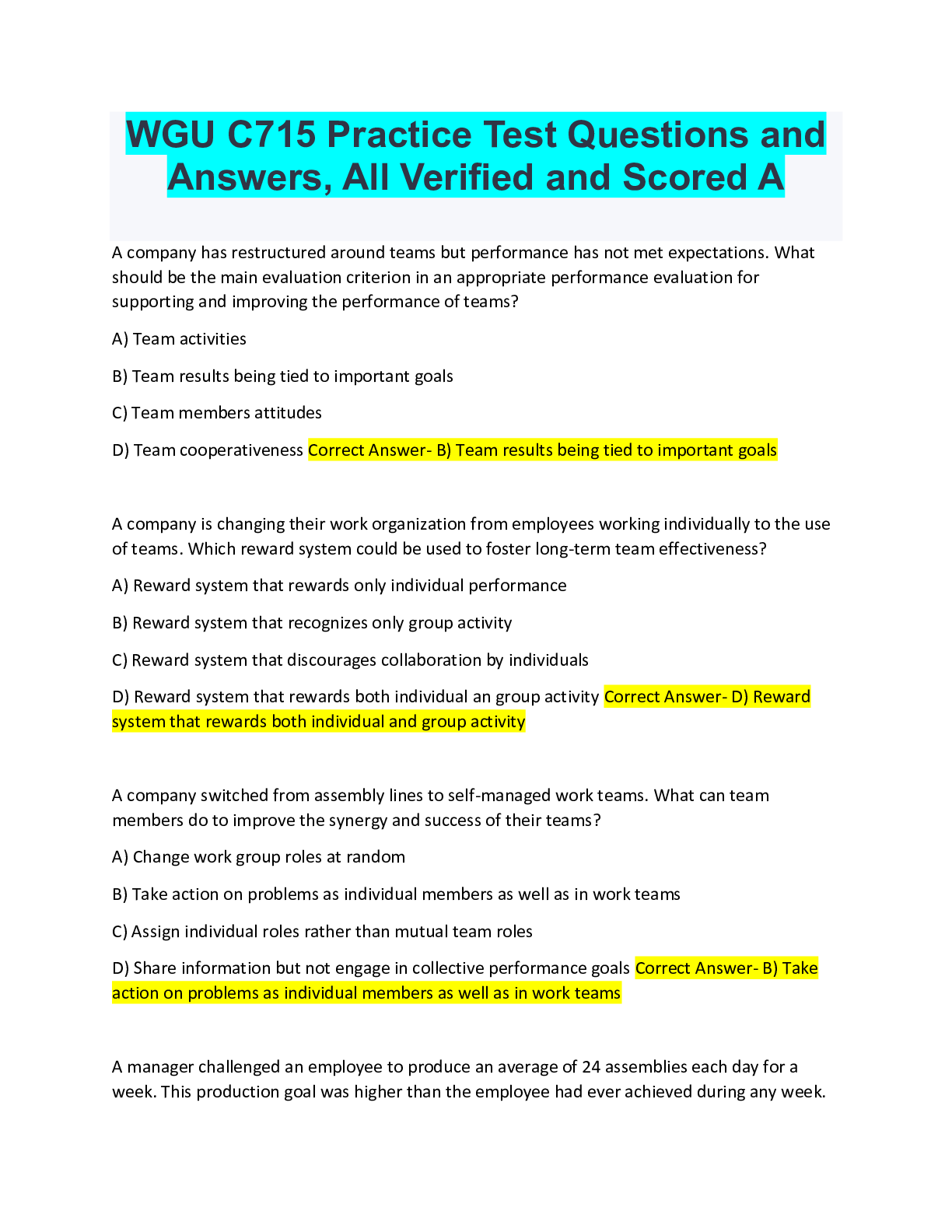
.png)

